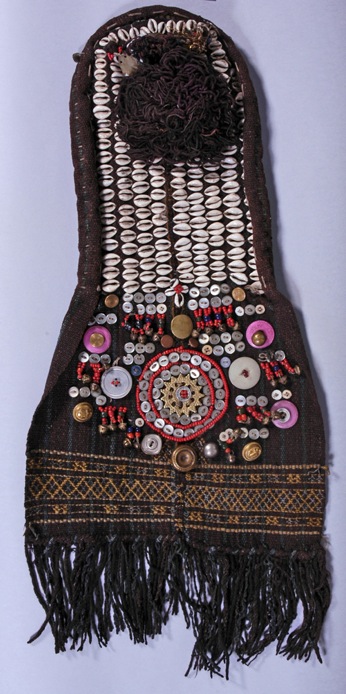Girl's headdress
Kalash people, Chitral, Pakistan
 Collected and purchased from Peter S.C. Parkes in 1983; 1983.20.5The Kalash are an isolated pocket of people who live in three high valleys in the eastern Hindu Kush, at the base of the Himalayas on the border between Pakistan and Afghanistan. They are the last local tribe who still practise their own ancient religion, despite being surrounded by millions of Muslims. They escaped conversion at the turn of the 20th century only because they were attached the princely state of Chitral, which at that time was at the tip of British India.
Collected and purchased from Peter S.C. Parkes in 1983; 1983.20.5The Kalash are an isolated pocket of people who live in three high valleys in the eastern Hindu Kush, at the base of the Himalayas on the border between Pakistan and Afghanistan. They are the last local tribe who still practise their own ancient religion, despite being surrounded by millions of Muslims. They escaped conversion at the turn of the 20th century only because they were attached the princely state of Chitral, which at that time was at the tip of British India.
The Kalash claim to be descended from Alexander the Great. Like the Greeks they observe a polytheistic religion that includes an omnipotent creator god as well as secondary gods of shepherds and flocks, honeybees, and homes and family, and so on. One of the biggest and most important festivals of the year is Chaomos, held at the time of the winter solstice. Chaomos celebrates Balomain, a heroic demi-god, and features activities such as ritual purification, bonfires, dancing, sacrifice, flirting and feasting. It is a time when members of the villages dress in their finest clothing and for girls and women this includes a magnificent headdress known as kupas.
This kupas is given to girls by their uncle at a rite of passage into female identity at around five years of age. This signifies that they are no longer sexless children, but little girls who will grow into women. From this point on, the girls are not allowed to cut their hair. It is braided into chui, the five long plaits worn by all Kalash women, with one at the front and an extra long one at the back that extends down to the lower back and is tied with a small bell.
For everyday wear, the women still wear traditional dark gowns accessorized with colourful bead necklaces and a cowrie-decorated pillbox-type hat (shushut). The kupas is only worn on special occasions and, after receiving their first one, the girls and women are responsible for making their own, often during the cold winter months when they are snowed in their homes. The headdress consists of a long, thick piece of wool, which the women would spin, weave and dye themselves. This is then covered in cowrie shells, beads, metal pendants, bells, buttons and a woollen pompom. It can weigh up several pounds. The cowrie shells are traded from the coast, so these indicate wealth and influence. For the special occasions it is worn, it may also be stuck with feathers and pieces of lavender, and the girls wear thick black make up around their eyes and forehead.
Kalash men, who now tend to wear Muslim dress in everyday life, also dress up for the Chaomos festival. The elders lead the procession from the altar of Balomain to the village wearing bright coats covered in silver or gold brocade and rolled woollen caps decked with sprigs of holly oak and juniper, feathers, and beads.
